Vermont
| |
|
Randolph City |
Vermont |
USA |
Armillary Sphere |
Dial 266 |
| 10 foot Cor-ten steel, concrete Entitled: Armillary VII. Contains an ecliptic ring, an equatorial ring and a gnomon ring. Engraved with the signs of the zodiac. |
| |
| |
 |
Redding |
California |
USA |
Horizontal Dial |
Dial 518 |
| When is a bridge not a bridge? When it's almost a sundial. The 217 foot high suspension span called Sundial Bridge wants to be a sundial, and has come very close. The suspension pylon is aligned true north, but unfortunately performs as an inaccurate gnomon with an inclination of 49 deg (for bridge functionality) rather than for the 40.6 deg latitude of the site. The bridge is 700 feet long and weighs 1,600 tons. Funding for the bridge comes from the McConnell Foundation, Redding Redevelopment Agency, Federal Highway Administration, and Turtle Bay Exploration Park |
| |
| |
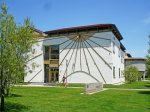 |
Redlands |
California |
USA |
Vertical Dial |
Dial 658 |
| A 60x40 foot vertical dial of stucco, wood and brass, filling the south exterior wall of the building. Roman hour numerals show PST; Arabic hour numerals show PDT. Summer and winter solstice and the equinox lines are shown; the shadow of a nodus on the gnomon indicates the date.
Dr. Nordgren explains that the shadow of the 10-inch diameter nodus "is just the right size to take into account periods when sundials are fast or slow relative to clock time. When dials run their slowest, the leading edge of the nodus shadow gives the accurate time. During periods when dials run their fastest the trailing edge gives the accurate time."
Dr. Nordgren was among the seven designers of the sundials used on the NASA Mars Rovers in 2004. |
| |
| |
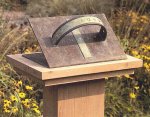 |
Redlands |
California |
USA |
Equatorial Dial |
Dial 293 |
| Equatorial dial designed by Russ Busher. A semicircle of metal, pierced with numerals. Sun shines through numerals onto metal plate with vertical line mounted below. Semicircle in equatorial plane, plate in polar plane. Such a dial is frequently advertized in "Wind and Weather" catalog. Placed atop a wooden post. |
| |
| |
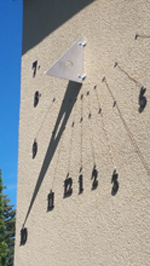 |
Regina |
Saskatchewan |
Canada |
Vertical Dial |
Dial 878 |
| This vertical dial is mounted directly onto the stucco wall of the house. The gnomon is a triangle of aluminum cut from 3/16 inch sheet, with a 2-inch hole as a breather to relieve stress from cross winds. More interesting are the hour lines, made of a double strand of heavy copper wire, with each extending from winter to summer solstice, held with pegs (from Canadian Tire). A middle peg shows the equinox as well. Hour lines extend from 7am to 6pm, shown in simple Arabic numbers. The sundial is operational in clear weather from 8:30am - 6pm through all seasons. |
| |
| |
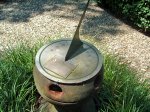 |
Rehoboth Beach |
Delaware |
USA |
Horizontal Dial |
Dial 321 |
| A bronze horizontal dial about 18 inches in diameter. The sundial was designed by Col. W.S. Corkran in 1930 and placed in the Homestead House garden, a 3 1/2 acre site maintained by the Rehoboth Art League since 1938. Col. Corkran died in 1962. The sundial was restored in 1999, set atop a capstan from an old sailing ship. Since 1999 the salt air has continued to deteriorate the plaques and gnomon. The dial face is still quite readable, with Arabic hours from 6am to 6pm delineated in 5 minute intervals. Symbols of the zodiac decorate the dial in a circular arc. |
| |
| |
 |
Renton |
Washington |
USA |
Horizontal Dial |
Dial 524 |
| A 44 x 60 foot horizontal dial with 20 foot tall stainless steel gnomon. This may be the largest horizontal dial in the state of Washington. Five colors of concrete define distinct parts of the dial and pathways (the 8 o?clock and 5 o?clock hour lines are walkways between buildings). Other hour lines have concrete benches and stainless steel discs to mark each hour, plus inlaid bronze discs for daylight saving time.
Hour lines have inset disks to indicate the hour, one disk for each counted hour 6 AM to 7 PM. The mid-day N-S hour line features thirteen hour disks; the previous hour has 12 disks and the next hour is marked with two disks. The N-S hour line may include one disk that is also a light to illuminate the gnomon at night. |
| |
| |
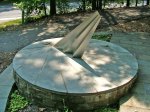 |
Reston |
Virginia |
USA |
Horizontal Dial |
Dial 369 |
| A modernistic seven foot diameter flagstone horizontal dial with hour lines. The design features a gnomon of folded stainless steel plate. Gnomon is truncated too short for shadow to reach edge of dial face. See "Sightings" in NASS Compendium Vol. 6 No. 4, Dec 1999. |
| |
| |
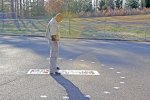 |
Reston |
Virginia |
USA |
Analemmatic Dial |
Dial 773 |
| An analemmatic dial with 8 foot semimajor axis painted on the asphalt playground of the Neil Armstrong Elementary School. Hour marks for 5 AM to 7 PM include longitude correction; Arabic hour numerals for both standard and daylight saving time are shown. The date line is decorated in bright colors with icons symbolic of holidays and seasonal weather.
The dial was the Boy Scout Eagle Service Project of William T. Spriggs and was painted by local Boy Scouts and their fathers. |
| |
| |
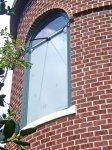 |
Richmond |
Virginia |
USA |
Vertical Dial |
Dial 635 |
| An 87 x 37 inch vertical stained glass sundial in a second story window on the south wall of a tower at Richmond Hill, a historic monastery in Richmond. The glass area of the dial is frosted with hour lines and numerals read from the inside. Richmond Hill is open to the public Tuesday through Sunday; visitors are welcome to view the sundial, which is located in a tower accessible from the main lobby entrance. |
| |
| |
|
Richmond |
Virginia |
USA |
Obelisk or Vertical Gnomon |
Dial 173 |
| 'Built in 1981 after an article in Scientific American (Dec 1980 "The Amateur Scientist") described a computer program for building a gnomonic dial with analemma hour lines. The dial was painted on the museum's parking lot, using a ball atop a 25 ft aluminum flagpole as the nodus. Semi-annual analemmas were painted in different colors, allowing correction for the equation of time. The dial was refurbished June 1992. |
| |
| |
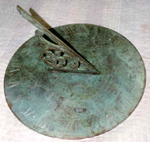 |
Richmond |
Virginia |
USA |
Horizontal Dial |
Dial 977 |
| A bronze dial 11.5 inches in diameter, 21 inches high. It is signed by Thomas Hart and dated 1765. The inscription on the dial implies a much later date of late 1800's or early 1900's. |
| |
| |
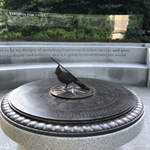 |
Richmond |
Virginia |
USA |
Horizontal Dial |
Dial 994 |
| A large circular plaza holds 7 life sized bronze statues of influential Virginia women during the last 400 years. The plaza will eventually feature 5 more life-size bronze statues. Dedicated in Oct 2019 this monument is a work in progress with other women still to be recognized. In the center of the plaza on a wide circular granite pedestal is a bronze horizontal sundial. In addition to the normal dial furniture of compass rose, inscriptions, site latitude & longitude, and a chapter ring with the hours from 5am to 7pm there is additional information: points of interest in Virginia shown around the dial in the outer chapter ring. Each location is listed by name, azimuth, and distance from the Capitol site. Underneath the style of the gnomon is a bronze Northern Cardinal, the state bird of Virginia. |
| |
| |
 |
Richmond Hill |
Ontario |
Canada |
Horizontal Dial |
Dial 1063 |
| Weathered Bronze/Copper horizontal dial approx. 18 inches (47cm) square. Hour lines in a square chapter ring extends from 4:30am to 7:30pm in 10 minute intervals, including a noon-gap for the width of the gnomon. Hour marks are in Arabic numerals. At the center is a simple compass rose pointing to the four cardinal points. On the southern portion of the dial beneath the gnomon's foot is a table for Equation of Time correction including longitude correction to provide Civil Time. |
| |
| |
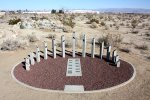 |
Ridgecrest |
California |
USA |
Analemmatic Dial |
Dial 679 |
| A 20x15 foot axis analemmatic dial built of cement hour posts, metal markers and tile and lava rock on the high desert floor outside the museum building. |
| |
| |
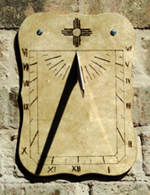 |
Ridgeland |
Mississippi |
USA |
Vertical Dial |
Dial 886 |
| This is a small 7 x 10 inch vertical dial declining due south. It is made from wood with hour lines, half hour lines, and Roman numerals engraved using a wood burning tool. The simple gnomon is 1/8 inch steel. |
| |
| |
 |
River Falls |
Wisconsin |
USA |
Vertical Dial |
Dial 185 |
| The inspiration for this sundial, at one time the largest vertical dial in the world, came from Dr. Swensen visiting Heidelberg castle that had a large vertical dial on the wall of the castle. Construction of the Univ. of Wisconsin dial began in 1994 on the south wall of the Kleinpell Fine Arts Building. The result is a 30 x 56 foot vertical dial of anodized aluminum with analemmic hour markers, and day lines to mark winter and summer solstice, Candelmas (1/31), Martinmas (11/10), Beltane (5/8) and Lammas (8/4), vernal and autumnal equinoxes. The massive south-facing vertical dial takes up the entire wall of the three-story fine arts building. The hour markers are gold on the 'Spring' side and brown on the 'Fall' side with 7 day intervals marked on each. |
| |
| |
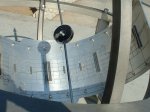 |
Riverside |
California |
USA |
Equatorial Dial |
Dial 18 |
| An equatorial dial 47 inches in diameter made of stainless steel. It sits upon four sleek pillars setting on a concrete rise. The gnomon rod has a round disk with a hole to act as a nodus. The dial equatorial band has solstice and equinox lines, as well as a line showing the declination of the sun marked with by months and zodiac signs. Hour lines are marked by raised stainless steel Roman Numerals. Dial is corrected to Pacific Standard Time. |
| |
| |
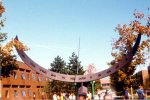 |
Rochester |
New York |
USA |
Equatorial Dial |
Dial 60 |
| A large 40 foot equatorial dial. The dial band is about 5 feet wide with raised Roman numerals at each hour mark. The gnomon is a rod approximately 15 feet long, ingeniously suspended by wires at the center of the dial. No shadow of the support wires can be seen, just the line of the gnomon appears on the dial band. |
| |
| |
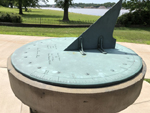 |
Rock Island |
Illinois |
USA |
Horizontal Dial |
Dial 632 |
| A horizontal dial approximately 30 inches diameter reportedly cast from an old brass (bronze, likely) cannon and weighing 175 pounds. Dial was weathered and damaged by vandals but restored in 1970 using black light to reveal the original engraved markings, which were re-engraved. Hours marked in Roman numerals with 2 minute marks. Noon gap mark aligns with North mark on base. The dial sits on a limestone base carved with crossed cannons and belt, date 1877. |
| |
| |
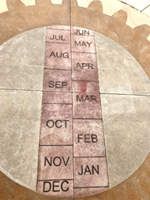 |
Rock Island |
Illinois |
USA |
Analemmatic Dial |
Dial 974 |
| This analemmatic dial is 20-foot wide within a 30-foot circle, all made of colored concrete. The Arabic dial hour markers follow an ellipse from 6 am to 6 pm. The dial is decorated with a botanical and Rotary Club theme. Gears and the Rotary 4-way test are interspersed with flowers and leaves of the four seasons. |
| |
| |
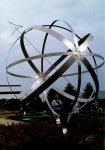 |
Rockford |
Illinois |
USA |
Armillary Sphere |
Dial 401 |
| A large stainless steel armillary dial approximately 10 feet in diameter. The equator and sunrise/sunset meridian bands are about 6 inches wide, with other bands about 3 inches wide. The central gnomon is a stainless steel rod with an open shaped arrow point and tail. The hours on the equatorial ring are raised bronze roman numerals with 15-minute intervals marked by bronze dots. The time marks are set for daylight saving time, with sunset at VII. Marks continue to VIII |
| |
| |
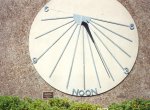 |
Rocklin |
California |
USA |
Vertical Dial |
Dial 238 |
| Small, circular 12.5 in. vertical dial mounted 56 in. above ground on the south wall of the library. Dial is aluminum mounted on concrete. Hour line missing from 6AM to gnomon base. Wall faces 26 degrees SW. Hour lines, numbered only at 6, 9, 12, 3 and 6. Two memorial plaques adjacent to dial. One reads 'Sierra College Honors/ E. R. 'Russ' Fallon/ for Dedicated Services/ Building Inspector/ Building and Grounds Supervisor/ 1959-1975'. Other reads 'In Admiration and Fond Memory/ of Our Colleague/ Dwight Hall/ 1927-1972/ by the/ Academic Senate and Friends/ at Sierra College.' |
| |
| |
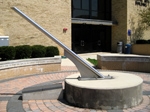 |
Rockville |
Maryland |
USA |
Horizontal Dial |
Dial 823 |
| A simple stainless steel gnomon 5-inches in diameter sits on a 6-foot concrete dais. Surrounding the dais are brick pavers with two circular bands of granite pavers. The interior band is for daylight saving time hours of engraved numbers filled with a gold color and a similar outer band for standard time hours. The granite pavers also mark the cardinal points engraved in gold, and extended as east-west and north-south lines from the dais. What makes this dial both unique and beautiful is the low brick and concrete surrounding walls with inscriptions from famous authors on both the interior and exterior faces. |
| |
| |
 |
Rolla |
Missouri |
USA |
Sun Alignment |
Dial 301 |
| Stonehenge-like half-scale model. 5 trilithons. A south-facing trilithon carries a pierced brass plate which projects a spot of sunlight on a folded analemma pattern. Stone. |
| |
| |
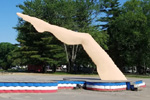 |
Roselawn |
Indiana |
USA |
Horizontal Dial |
Dial 971 |
| This dial consists of a fiberglass 18-foot high 36-foot gnomon in the shape of a bare tan-colored human leg. Hence the dial's name of "The Leg". The tip of the toe acts as a nodus. There are no hour lines and no declination lines. Instead, during summer months a series of hour markers are arranged on ground beneath the path of the nodus shadow. |
| |
| |
|
Roswell |
New Mexico |
USA |
Horizontal Dial |
Dial 490 |
| A beautiful bronze sundial sits on a pillar of rough marble. It was given to the Library by the Roswell Womens Club at the turn of the 20th century. Unfortunately the dial is damaged, but the Roswell Womans Club is searching for someone to repair the dial. |
| |
| |
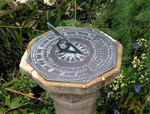 |
Round Lake Beach |
Illinois |
USA |
Horizontal Dial |
Dial 802 |
| This is an octagonal-shaped horizontal dial 240 mm (9.5 inches)across. The photo-etched plate has a central compass rose and delineated with a half hour circle and second circle dividing the time into quarter-hour increments. Roman numerals mark the hours from 6am to 6pm, with an extra hour mark to extend the dial's time-telling from 5am to 7pm. The dial is adjusted for the longitude of the site. Atop the dial face is a sturdy filigree gnomon approximately 5mm wide and 90mm (3.5 inches) high. South of the gnomon is a graphic Equation of Time. |
| |
| |
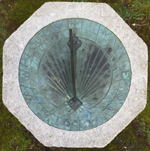 |
Saanich |
British Columbia |
Canada |
Horizontal Dial |
Dial 935 |
| The dial is simply but pleasingly decorated. The gnomon is plain. The pedestal is carved from stone taken from ruins of the Basilica of Ste. Anne de Beaupre in Quebec. The Quebec connection is indicated by the use of a Fleur De Lys on the dial face, and Napier's Scottish heritage is referenced by thistle motifs on brass accoutrements fitted to the pedestal. |
| |
| |
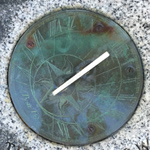 |
Saanichton |
British Columbia |
Canada |
Horizontal Dial |
Dial 936 |
| A simple horizontal bronze sundial about 9 inches in diameter. A sun occupies the interior of the dial with hour lines extending to a chapter ring with Roman numerals marking the hours. Each hour is divided into eight parts along the outer edge of the dial. The dial sits on a square plinth with corresponding square stepped base. |
| |
| |
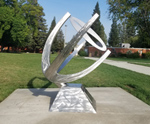 |
Sacramento |
California |
USA |
Equatorial Dial |
Dial 1024 |
| A 6 foot wide x 5-foot high burnished stainless steel equatorial sundial. The meridian arc is parabolic shaped and the equatorial arc is slightly more than a gracefully tapered half-circle 5 1/2-feet in diameter. The central elliptical gnomon plate, which swivels to face the sun, has an analemma cutout that casts an accurate civil-time shadow onto the equatorial ring below. The gnomon plate is laser-etched with the analemma, months and 365 days of the year, and marks for the equinoxes and solstices, and instructions. The equatorial timeline is laser-etched with hour and minute marks from 6:30 AM to 6:30 PM. The sundial body rotates and locks in position for either Daylight Saving or Standard Time. The sundial is highly accurate compensating for longitude (the equatorial ring is rotated 5min 24 sec early to measure solar time on the pacific meridian) and equation of time (by reading the east or west edge of the analemma plate gnomon shadow). The sundial often indicates clock time to within seconds and the date to within a portion of the day. A stainless steel base cover encloses the mounting hardware beneath. |
| |
| |
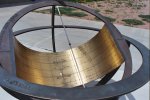 |
Sacramento Peak |
New Mexico |
USA |
Cylindrical Dial |
Dial 317 |
| The bronze cylindrical dial is 5-foot in diameter. The dial reads time and date from a rod gnomon cast onto an engraved, equatorial band. The dial shows date bands and solar time corrected for longitude (3 min 17s west of the 105 degree meridian). The dial is accurate to about one minute. At the noon hour line is an analemma showing the correction to mean time. The armillary sphere was designed and built by observatory staff members Dr. Don Neidig, Scott Gregory, and Mitchell Davis. |
| |
| |
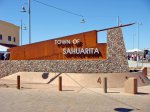 |
Sahuarita |
Arizona |
USA |
Obelisk or Vertical Gnomon |
Dial 623 |
| An unusual dial by John Carmichael using a gnomon tip to cast the shadow to indicate time. The dial face is poured concrete with inlaid metal longitude-corrected hour lines, and is nearly horizontal, inclining just 1.27 degrees for water drainage. It declines 89.28 degrees east of south. Bronze plaque has User Instructions and an Equation of Time Graph. Dial functions best during the middle part of the day. The style shadow lies outside of the dial face boundaries in the early mornings and late afternoons. The massive elaborate base that supports the gnomon rod is made from stacked flagstone. A waterfall cascades from the back south side of the base and flows a long distance to the south through a canal that has several water fountains and pools along the way. Around the base is a planter with bedding plants. The base and gnomon are lighted at night. |
| |
| |
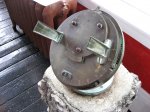 |
Saint Anthony |
Newfoundland |
Canada |
Heliochronometer |
Dial 169 |
| A Pilkington & Gibbs Heliochronometer, 9 in. diameter, 9 in. high bronze with two sights, 3 x 1.5 in. Points of compass on dial base, months and dates on face. Rotates to compensate for EOT. Dial is a circular plate, mounted to allow adjustment for latitude. Gnomon consists of two cast posts with vertical slits, about 6 in. high, on opposite sides of plate. Another adjustable scale permits EOT corrections. It was part of original house from 1909-1939. Not dated, but the chronometers were sold between 1907-1914. Now on display in museum and not set up for use. Heavily patinated with some corrosion. Fabricated by Pilkington & Gibbs Ltd, Preston England, # 433. The dial is mounted to a solid Labradorite pillar, 1 foot square, 21 inch high. |
| |
| |
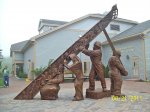 |
Saint John |
New Brunswick |
Canada |
Horizontal Dial |
Dial 743 |
| A large horizontal dial whose cast metal gnomon is a sculpture commemorating the Canadian National Day of Mourning. The gnomon is supported by statues representing toiling laborers. The surrounding brick courtyard includes bricks marked with Roman hour numerals.
The dial sculpture is identified as the Day of Mourning Monument and was dedicated on the Canadian National Day of Mourning, April 28, honoring those workers in Canada who have been killed, injured or disabled on the job. |
| |
| |
 |
Saint Louis |
Missouri |
USA |
Sun Alignment |
Dial 1042 |
| The sundial, or more properly an alignment gap in the shape of a cross, is cut into the south wall of the new mausoleum in Bellefontaine Cemetery and Arboretum The cross shaped gap was cut into a 32,000-pound block of granite located at the top of the second flight of stairs, carefully angled at 27.9 degrees through this two-foot-thick block. Every year, on December 20th at 11:58 am, the sun shines through the cut and projects a cross 4x 8 feet in size on the granite floor located at the bottom of the stairs. The cross illuminates the floor for about 4 minutes, only aligning on December 20th at solar noon. |
| |
| |
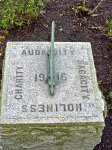 |
Salem |
Oregon |
USA |
Horizontal Dial |
Dial 708 |
| A 14 inch square California granite horizontal dial with a bronze gnomon with hour and half-hour marks and Roman numerals showing PST. Dial face is engraved with the Class Year 1916 and the motto Audacity, Sagacity, Holiness and Charity. The gnomon may have been replaced since originally installed. The dial is atop a gray granite pedestal integral to the dial itself.
The June 8, 1916 Collegian university newspaper provided this: "In presenting the sundial to the university, Walter Gleiser, president of the class, gave a forceful speech in which he portrayed the never-failing accuracy of the instrument's function, believing that it would be of use to the community, and that it should symbolize the good that students of Willamette should be to the world." |
| |
| |
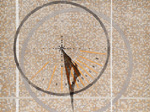 |
Salem |
Oregon |
USA |
Vertical Dial |
Dial 1103 |
| This vertical declining sundial is form with small squares of tile, showing the hours within a dark grey circle of tiles. The hours are marked by long orange-tile hour lines while the half-hours are marked by two dark grey tiles. A secondary circle of light grey adorns the wall, showing the length of the shadows and making the dial aesthetically pleasing. The background tiles are porcelain in common designer colors. The gnomon is a substantial stainless steel shape formed with a hole and curving points on the downward side, allowing leaves and small branches to slide off. |
| |
| |
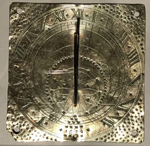 |
Salem |
Massachusetts |
USA |
Horizontal Dial |
Dial 124 |
| Here is a bronze dial approximate 8 inches in diameter with the date 1644. In spite of its age, it is now highly polished showing little if any wear to lines, engraving, and mounting holes. Roman hour numbers go from 5am to 7pm and the chapter ring is divided into quarter hours. The dial face is square and outside the hour ring are many small 5-point stars, stamped with a tool. The dial looks different from those made in London and the Proctor family immigrated to the New World in1635. Measuring the hour lines, the dial was probably made for Salem at 42.5 deg latitude. However an analysis of the hour lines shows the best fit latitude is 44.5 deg. The dial was presented to the Peabody Museum in 1907 by Abel Proctor and is attributed to John Proctor, who along with his wife Elizabeth, were accused of witchcraft in 1692. At the time Proctor was a wealthy tavern owner, but nevertheless was hanged. His wife was spared due to the fact she was pregnant, but remained "convicted" through out her life. |
| |
| |
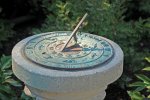 |
Salem |
Massachusetts |
USA |
Horizontal Dial |
Dial 131 |
| Approx. 10 inch diameter cast bronze horizontal dial. Inner ring has zodiac signs, middle ring has cherubs, leaves and a crown, and outer ring has hours 4AM-8PM in Roman numerals but no hour lines. The 6AM and 6PM lines are opposite each other but their hour lines do not pass through the root of the gnomon. It is believed the dial was installed about 1910 by then owner Caroline Emmerton. The dial was moved in 2007 to a less sunny location to make room for a seaman's memorial sculpture. The dial pedestal is traditionally decorated stone with circular top |
| |
| |
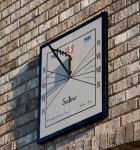 |
Saline |
Michigan |
USA |
Vertical Dial |
Dial 631 |
| A north-facing vertical dial of wood approximately 30 inches square with steel gnomon. Gnomon support includes "M M" representing 2000 millennium. Dial face includes script "RJ" for owner's initials as well as additional "M M" symbology. Hour markings show Eastern Standard Summer Time. Dial is displayed during summer months only, during which time it can be seen from the street.
Dial is on private property but can seen from a public street. |
| |
| |
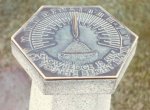 |
Salt Lake City |
Utah |
USA |
Horizontal Dial |
Dial 114 |
| Horizontal brass dial with a hexagonal shape, about 8 inches on a side. .Unusually small gnomon, only about 4 inches high. A beehive in relief is pictured at the base of the gnomon, perhaps explaining the hexagonal dial shape. Roman numerals with hour and quarter hour lines. Dial sits on a hexagonal pillar. |
| |
| |
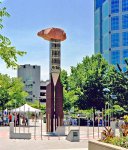 |
Salt Lake City |
Utah |
USA |
Obelisk or Vertical Gnomon |
Dial 347 |
| A 24 foot tall azimuth dial in a complex sculpture comprising a light projection gnomon within a 36 foot diameter base with numerous additional shadow-casting structures. The "Asteroid Landed Softly" sundial sculpture was created in 1993 by architect Kazuo Matsubayashi. The sculpture symbolizes the concepts of space and time: space as a large boulder (asteroid) sitting on a square pedestal; and, time as an azimuth sundial that shows the path of the sun through the day and seasons. |
| |
| |
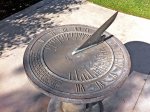 |
San Bernardino |
California |
USA |
Horizontal Dial |
Dial 188 |
| A 23 inch diameter horizontal bronze dial with 12 inch high gnomon and with hour, half-hour and quarter-hour lines from 5:30 AM to 7:30 PM and Roman hour numerals from 5 AM to 7 PM. Dial sits atop a 27 inch diameter stone pedestal 37.5 inch high. |
| |
| |
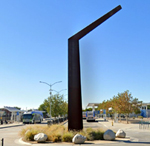 |
San Bernardino |
California |
USA |
Horizontal Dial |
Dial 1041 |
| This is a monumental horizontal sundial that from the ground simply looks like a giant pole with a slanting beam. High above the ground that beam is actually a segment of a gnomon, casting its shadow on the concrete plaza below. Then, if the eye is discerning, the concrete alternates in light gray and darker gray motif for the hour sections. From space (or Google Earth) the layout of the hour angles is clearly visible, radiating from a point considerably south of the gnomon pole, showing the hours from 9AM to 3PM local solar time. Hour line plaques extend from 10AM to 7PM. |
| |
| |
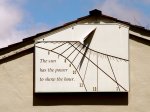 |
San Carlos |
California |
USA |
Vertical Dial |
Dial 424 |
| This vertical dial is approximately 4 foot high by 6 foot long, mounted on the end wall of a house that can be publicly viewed. Dial has hour lines and lines marking the equator and solstice shadow limits. Made of wood and brass. |
| |
| |
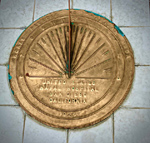 |
San Diego |
California |
USA |
Horizontal Dial |
Dial 1079 |
| Farenholt sundial for U.S. Naval Hospital San Diego California. This cast bronze dial was designed and commissioned by RADM Farenholt for U.S. Naval Hospitals at bases where he was commanding officer, visited, or had special meaning to him. The dial is 18 inches (46cm) in diameter. The outer chapter ring has the motto, followed by a chapter ring with Arabic hours 6am to 6pm, raised hour lines that radiate from near the foot of the gnomon and short half-hour lines. The gnomon has graceful curves original had a trefoil cut-out in the center. The restored gnomon has an irregular cut-out based on a photo of the original gnomon's shadow. Below the gnomon is the naval command name, followed by the commissioning date in the southern portion of the hours chapter ring. Dial has been restored, now having a gold luster. |
| |
| |
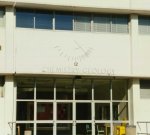 |
San Diego |
California |
USA |
Vertical Dial |
Dial 19 |
| Above the southwest entrance of the Chemistry-Geology Building is a vertical declining dial built by Richard L. Threet in 1979. The dial uses thin aluminum tubing as a gnomon to cast shadows on a ring of hour and half hour lines approximately 9 feet in diameter. The lines were originally painted black on the white concrete wall with only the 9 am, 12 noon, 3 pm and 6 pm lines boldly numbered. Since then the dial has lost all but the 12. |
| |
| |
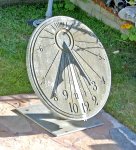 |
San Diego |
California |
USA |
Vertical Dial |
Dial 80 |
| This dial was originally owned and installed at Sea World in San Diego but was sold and purchased by Verlyn Kuhlmann. A 39 inch diameter reclining vertical dial of cast concrete with a 20 inch long steel gnomon. Dial reclines about 50°. Includes cast hour lines with Arabic numerals and longitude correction. A separate plaque provides instructions and an EOT graph. The dial is mounted on a 24 inch square aluminum base plate and short column support. |
| |
| |
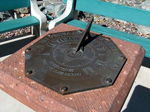 |
San Diego |
California |
USA |
Horizontal Dial |
Dial 213 |
| This is not the Koester dial at SDSU, but a far more interesting horizontal dial originally dedicated to the San Diego Normal School for elementary teaching by the class of June, 1911. The 18-inch octagonal bronze dial was originally designed by San Diego Clock maker Joseph Jessop and mounted on a miniature Doric column. The dial was placed within the circular lawn directly in front of the school's main entrance at the intersection of Park and El Cajon Boulevards. |
| |